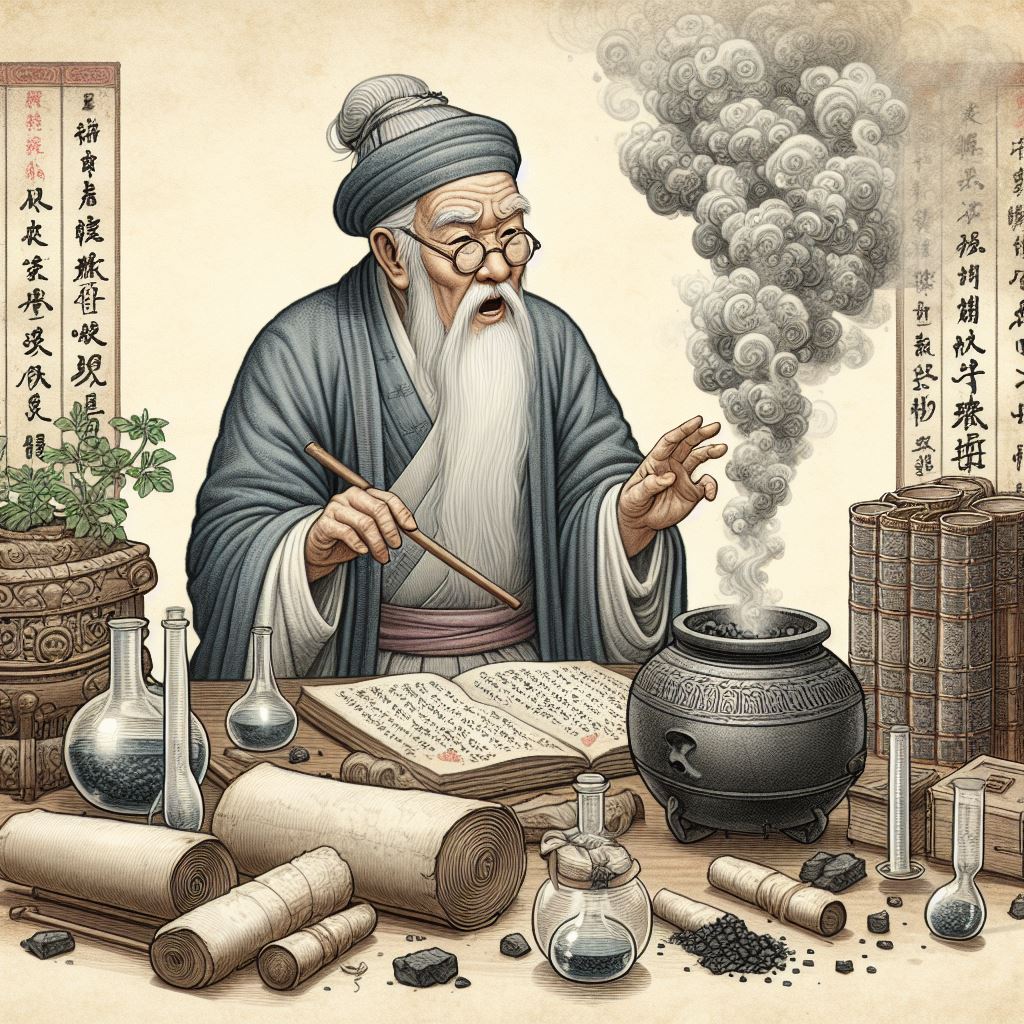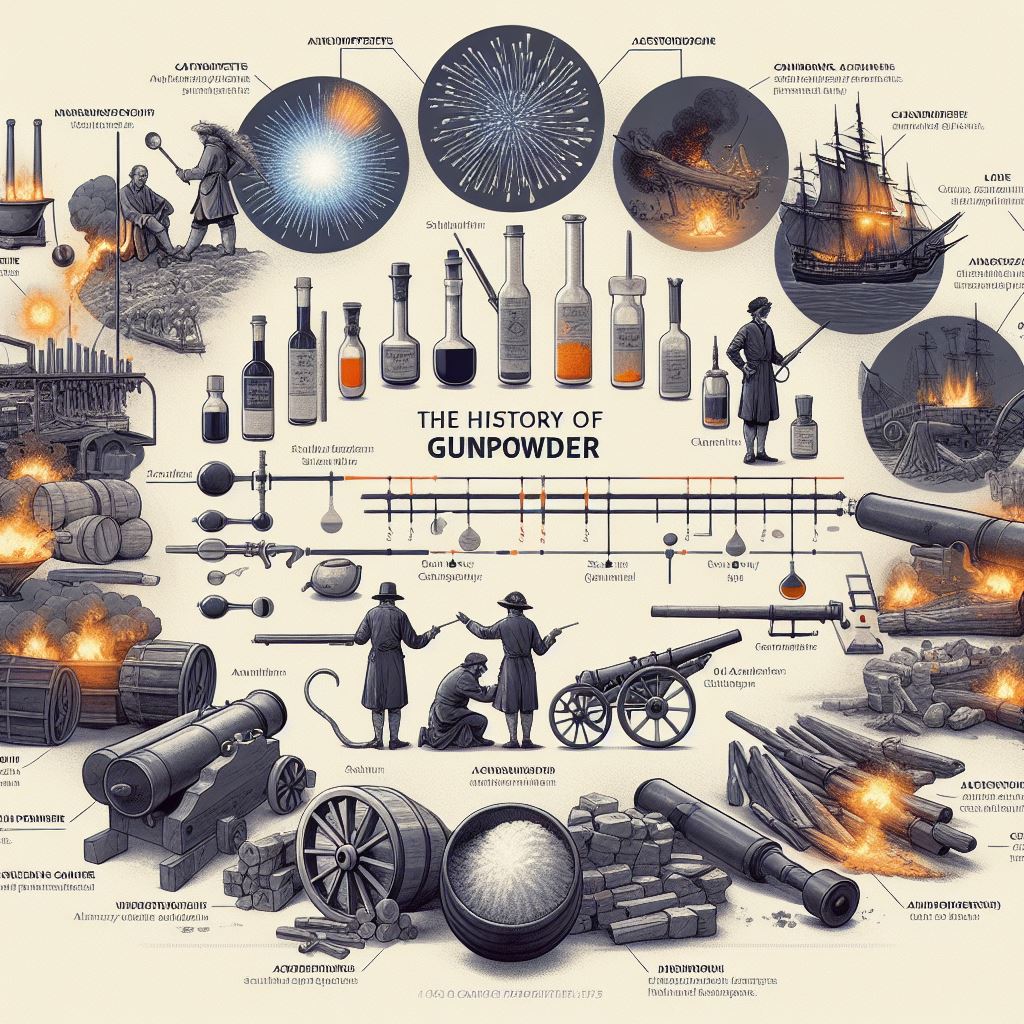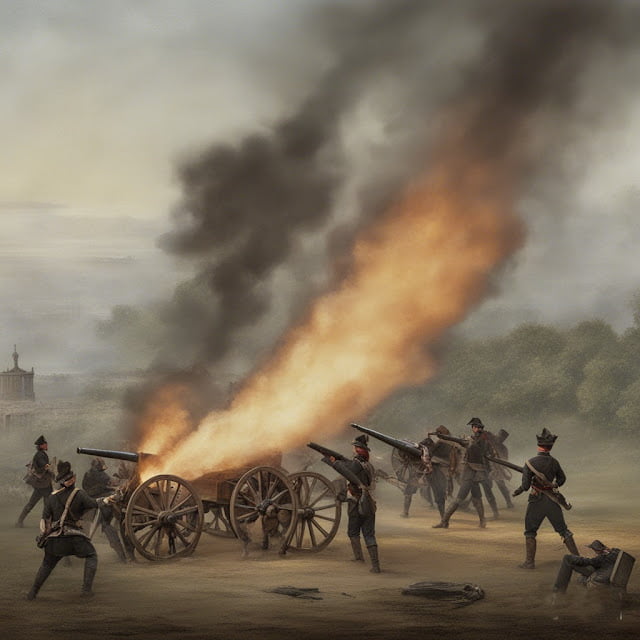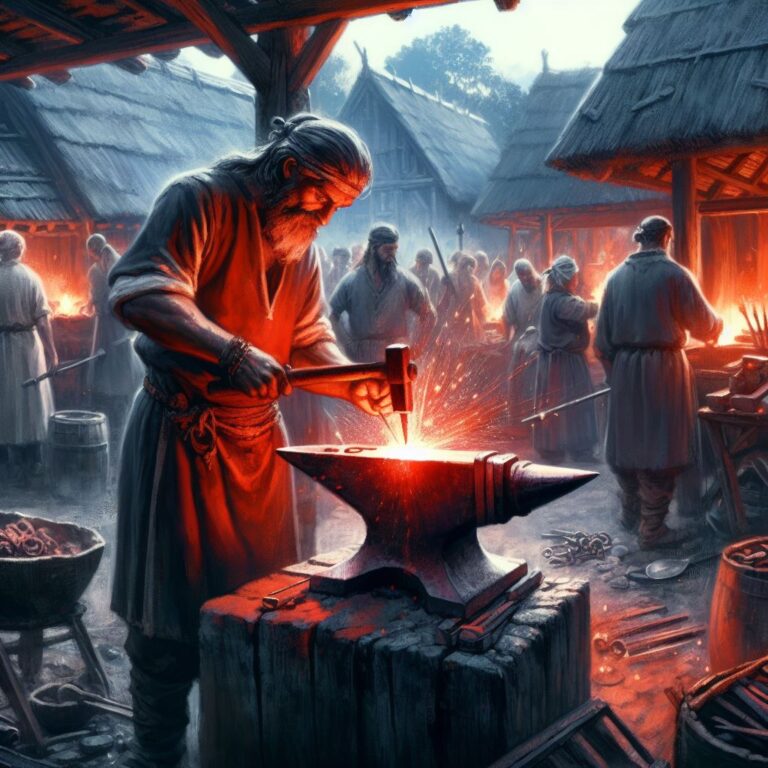Invention of Gunpowder
Imagine a world before the deafening roar of cannons, the acrid smell of smoke, and the awe-inspiring power of explosions. A world where empires rose and fell by the clang of swords, where battles etched their stories in blood and steel. Then, enter gunpowder, a potent concoction that ignited not just flames, but a revolution that reshaped history.
The story of the invention of gunpowder, also known as black powder, is a fascinating part of human history.. It is a mixture of Carbon, Sulphur, and potassium Nitrate, it has been used for military purposes, mining, transportation, and even entertainment. Sulpher and Carbon act as fuel and Pottacium Nitrate acts as an oxidizer. The first confirmed reference to gunpowder can be found in ancient China during Tang Dynasty, where it was used in multiple ways.
According to some theories, gunpowder was discovered accidentally by a Chinese alchemist during an experiment to create Exilir of life. The Chinese initially used gunpowder for medicinal purposes, but soon discovered its explosive potential. By the 11th century, gunpowder was being used in rockets and other incendiary devices. The Chinese also invented gunpowder cannons, which were used in battles.

Timeline of History of Gunpowder
When was gunpowder invented? Here is a timeline of the development and invention of gunpowder:
9th century:
As we know gunpowder is a mixture of charcoal, sulfur and potassium Nitrate (saltpeter), charcoal has been used for heating purposes and there is a mention of sulfur saltpeter as Liu and Hsiao found Chinese dictionary Chi Yun before the 6th century.
- Saltpeter: This common mineral, known as “earth saltpeter” in Chinese records, was readily available and easily extracted from soil and cave deposits.
- Sulfur: Used for centuries in medicines and dyes, sulfur’s flammable properties were well documented in ancient texts like the Shennong Bencao Jing (Divine Farmer’s Classic of Materia Medica).
- Charcoal: Produced from readily available wood, charcoal was primarily used for fuel and metallurgy, but its role as a combustible agent was not unknown.
The earliest whispers of gunpowder’s ingredients, documented in the Taoist text “Taishang Shengzu Jindan Mijue” (c. 850 AD), mention a mix of six parts sulfur, six parts saltpeter, and one part birthwort herb. Though intended for longevity potions, this combination held an explosive potential waiting to be harnessed.
Gunpowder’s accidental discovery of gunpowder by a Chinese alchemist during an experiment to create an elixir of immortality, ignited a revolution that reshaped warfare, industry, and culture.
11th century:
The Jin Dynasty saw the transformative use of gunpowder in a plethora of inventions. From dazzling fireworks that adorned celebrations to thunderous rockets and fire arrows used in warfare, the Chinese harnessed gunpowder’s explosive potential across various applications.
It wasn’t until the 11th century that these ingredients, through trial and error, accidental explosions, and perhaps a dash of serendipity, formed the first known formula for gunpowder. The “Wujing Zongyao” (Essentials of Military Technology) from 1044 AD documents a recipe of 75 parts saltpeter, 15 parts charcoal, and 10 parts sulfur, a composition remarkably close to the modern gunpowder formula.
The 11th and 12th centuries saw continued experimentation with gunpowder formulas, with texts like the Wujing Zongyao (Essentials of Military Knowledge) documenting improved mixtures and techniques. Bamboo tubes packed with gunpowder became the first proto-cannons, spitting fire and fear onto battlefields. Flamethrowers, bombs, and even primitive landmines emerged, revolutionizing warfare.
13th century:
The Mongol conquests introduced gunpowder to Europe, catalyzing a paradigm shift in military capabilities and technological exchanges. The Mongol Empire’s vast reach played a pivotal role in disseminating this potent mixture across continents, altering the course of history.
History isn’t always a clear-cut narrative, but clues paint a vivid picture of gunpowder’s eastward journey. Here are some key pieces of evidence:
- Mongol Siege of Baghdad (1258): Accounts of the siege mention the use of incendiary devices and “thunderous engines” that hurled projectiles, suggesting the early use of gunpowder weapons by the Mongols.
- Marco Polo’s Travels (1298): The famed traveler recounts witnessing the manufacture and use of “black stones” that exploded and propelled arrows, further solidifying the connection between the Mongols and gunpowder.
- Arabic and European Treatises: By the late 13th and early 14th centuries, treatises like Hasan al-Rammah’s “Book of the Art of Fireworks” and Roger Bacon’s “Opus Majus” contained formulas and descriptions of gunpowder weapons, indicating that knowledge of this technology had reached Europe and the Middle East.
The Mongols readily incorporated soldiers and engineers from conquered territories, including Chinese experts in gunpowder technology. These soldiers, serving in Mongol armies, carried their knowledge westward. Facing heavily fortified cities, the Mongols readily adopted and improved upon existing technologies, including gunpowder weapons. Their ability to adapt and integrate new tools proved crucial in disseminating gunpowder across their vast empire.
Beyond military campaigns, the Mongols fostered diplomatic and cultural exchanges with Europe and the Middle East. These interactions provided further avenues for the transmission of gunpowder knowledge and technology.
14th century:
While gunpowder had been known in Europe for some time, the 14th century saw a surge in its use, particularly in England. Records from the Tower of London, dating back to 1344, reveal the production of large quantities of gunpowder, highlighting its growing significance in military preparations. The earliest English cannons were small, hand-held weapons known as “bombards.” However, by the late 14th century, larger and more powerful siege engines emerged, capable of breaching fortified walls and revolutionizing siege warfare.
This early battle in the Hundred Years’ War is often cited as one of the first instances of gunpowder being used effectively on a European battlefield. Although the English victory is attributed primarily to other factors, the use of cannons demonstrates the nascent power of this new technology.

Evidence and Impact
- Tower of London records: These detailed records provide invaluable insights into the production and use of gunpowder by the English during the 14th century. They document the procurement of raw materials, the composition of gunpowder mixtures, and the deployment of cannons in various battles.
- Archaeological discoveries: Excavations of battlefields and fortifications have unearthed cannonballs, fragments of gunpowder barrels, and other artifacts that provide tangible evidence of the use of gunpowder in 14th-century Europe.
- Military treatises: Contemporary military manuals and treatises, such as the “De Nobilitatibus Sapientiae et Prudencie” by Walter de Milimete, discuss the use and construction of cannons, showcasing the growing understanding and appreciation for this new weapon.
15th century:
The Ottomans were early adopters of gunpowder technology, boasting impressive foundries and skilled engineers. Their massive cannons, nicknamed “bombards,” breached city walls with thunderous roars, playing a crucial role in conquering Constantinople (1453) and expanding their empire. Beyond siege engines, the Ottomans developed mobile cannons that accompanied their armies, providing overwhelming firepower on open battlefields. Their tactical use of artillery marked a significant shift from traditional cavalry-centric warfare.
This elite infantry unit, trained in firearms and disciplined tactics, became renowned for its effectiveness. Their proficiency with muskets and arquebuses (early matchlock muskets) gave the Ottomans a clear advantage over many rivals.

Evidence and Impact:
- Battle accounts: Detailed chronicles of Ottoman campaigns, like the siege of Constantinople, vividly describe the destructive power and strategic impact of Ottoman cannons.
- Archaeological discoveries: Excavated cannonballs and fragments from battlefields offer tangible proof of the widespread use of gunpowder weaponry.
- Military treatises: Ottoman military manuals, like the “Fathnama” by Mehmed the Conqueror, discuss the deployment and tactics of gunpowder weapons, showcasing their growing importance in military doctrine.
16th century:
Musket Mania: The 16th century saw the widespread adoption of muskets, more efficient and mobile than their arquebus predecessors. Improved firing mechanisms and standardized calibers further increased their reliability and effectiveness. Skilled gunsmiths and musketeers became highly sought-after commodities, with European mercenaries contributing to the spread of gunpowder technology across continents.
Gunpowder weapons revolutionized naval warfare, equipping ships with cannons and allowing infantry to engage in land and sea battles with greater firepower. The Ottomans utilized these advancements to expand their maritime reach and influence.
Evidence and Impact:
- Improved firepower: Records of battles like Lepanto (1571) reveal the increased lethality and rate of fire enabled by muskets, drastically altering battlefield dynamics.
- New military tactics: Manuals like the “Exercititium militare” by Pietro Monti highlight the development of new formations and strategies adapted to musket warfare.
- Global gunpowder wars: Gunpowder weaponry transformed conflicts beyond Europe, influencing warfare in Asia, Africa, and the Americas, leading to the rise of “gunpowder empires” across the globe.
17th century:
Before gunpowder, mining relied on laborious pickaxes and chisels, making it a slow and dangerous process. The 17th century witnessed the explosive emergence of gunpowder blasting, changing the game entirely. By packing gunpowder into drilled holes and igniting it, miners could break through rock formations with immense force and speed. This significantly increased productivity and safety, allowing for deeper excavations and the extraction of previously inaccessible resources.

Gunpowder blasting wasn’t limited to open-pit mining. Its controlled explosions facilitated the construction of tunnels and canals, crucial for transportation and infrastructure development. The Grand Canal in China and the Canal du Midi in France are testaments to gunpowder’s role in shaping transportation networks.
Evidence in action:
Archaeological discoveries of blasting chambers and gunpowder residue near historical mining sites provide concrete evidence of this widespread adoption. Additionally, contemporary engineering manuals, like Georgius Agricola’s “De Re Metallica” (1556), detail gunpowder blasting techniques, highlighting its growing importance in civil engineering.
18th century:
The black powder of the 17th century underwent significant improvements in the 18th century. With refined formulas and more efficient production methods, its potency and reliability increased, leading to more powerful and dependable weaponry.
Cannons grew larger and more sophisticated, boasting longer ranges and heavier projectiles. This resulted in devastating siege warfare, with fortified walls crumbling under the relentless bombardment of improved artillery. Advancements in firearms also made their mark on the battlefield. Muskets became more accurate and easier to reload, transforming infantry tactics and leading to the rise of linear formations for maximum firepower.
History books as witnesses:
- Despite the ascendancy of high explosives, gunpowder retained its place in specialized military applications. Tracer rounds, used for aiming at night, incorporated slow-burning gunpowder to illuminate the bullet’s trajectory. Tanks and anti-tank rifles also continued to utilize gunpowder-based propellants for their specific performance characteristics.
- The Art of Fireworks: Gunpowder’s legacy as a spectacle maker remained undimmed. Fireworks displays, with their vibrant explosions and dazzling patterns, continued to rely on the controlled combustion of gunpowder for their breathtaking displays. The beauty and tradition of fireworks ensured a continued demand for this ancient explosive.
- Preserving History: The history of gunpowder and its role in shaping warfare and cultural traditions also contributed to its continued production and use. Museums, reenactments, and heritage events employed gunpowder to authentically recreate historical battles and celebrations.
19th century:
In 1847, Ascanio Sobrero accidentally synthesized nitroglycerin, a liquid compound boasting five times the power of gunpowder. Its instability, however, posed serious safety concerns. Through the genius of Alfred Nobel, nitroglycerin was stabilized and transformed into dynamite, revolutionizing mining and construction. Throughout the late 19th century, various high explosives like cordite and picric acid emerged, offering greater power, reliability, and control compared to gunpowder. These advancements gradually displaced gunpowder in military applications, such as artillery shells and propellants.
In industries like quarrying and demolition, dynamite and other high explosives became the preferred demolition agents. Gunpowder’s slower burn rate and relatively weaker force rendered it less efficient in these contexts.
20th century:
Despite the ascendancy of high explosives, gunpowder retained its place in specialized military applications. Tracer rounds, used for aiming at night, incorporated slow-burning gunpowder to illuminate the bullet’s trajectory. Tanks and anti-tank rifles also continued to utilize gunpowder-based propellants for their specific performance characteristics. Gunpowder’s legacy as a spectacle maker remained undimmed. Fireworks displays, with their vibrant explosions and dazzling patterns, continued to rely on the controlled combustion of gunpowder for their breathtaking displays. The beauty and tradition of fireworks ensured a continued demand for this ancient explosive.
Applications Of Gunpowder
Following are some of the applications of gunpowder:
Military:
- From Spear to Shell: Gunpowder ushered in a new era of warfare, replacing slow-firing catapults and cumbersome siege engines with long-range cannons and rapid-fire muskets. The ability to kill enemies from afar with devastating firepower shifted power dynamics on the battlefield, empowering infantry and weakening the dominance of heavily armored knights.
- Fortified Walls Crumble: Castles, once considered impregnable fortresses, became vulnerable to gunpowder’s explosive might. Cannons breached thick walls with ease, forcing military strategies to adapt and evolve around siege warfare and fortification design.
- Logistics and Tactics Reimagined: Gunpowder’s impact wasn’t limited to weaponry. Supply chains had to adapt to transporting large quantities of explosives and ammunition, while military tactics embraced new formations and maneuvers to maximize firepower and minimize casualties.
Mining and quarrying:
- Taming the Earth: Gunpowder became an invaluable tool for breaking through hard rock and digging deeper into the earth. Mines and quarries, no longer limited to surface deposits, could access valuable resources like coal, salt, and precious metals, boosting resource extraction and fueling industrial growth.
- Tunneling Through Mountains: Blast-powered drilling and tunneling revolutionized infrastructure development. Canals, tunnels, and railway lines carved through previously insurmountable obstacles, improving transportation networks and facilitating trade.
- Safety Concerns Emerge: However, gunpowder’s volatile nature introduced new dangers in the form of accidental explosions and collapses. Mining regulations and safety protocols were developed to mitigate these risks and protect workers.
 |
| Gunpowder use in Mining |
Transportation:
- Early Engine Experiments: In the early stages of steam engine development, gunpowder was used in rudimentary experimental designs, offering a glimpse of the explosive power behind steam as a propellant.
- Blast-powered Propulsion: Gunpowder-powered rockets emerged as early forms of propulsion, paving the way for future jet engine and rocket technology.
- Indirect Influence: Although not directly fueling steam engines, gunpowder’s industrial and technological advancements contributed to the overall development of the transportation system, creating a demand for efficient modes of travel and influencing the infrastructure needed for steam-powered railways and ships.
 |
| Early Steam Engine |
Agriculture:
Gunpowder’s main component, potassium nitrate, does contain nitrogen, an essential element for plant growth. However, gunpowder is not a practical or efficient form of fertilizer due to its high cost and uncontrolled release of nutrients, which can damage crops and pollute the environment.
- Limited Use in History: While some historical records mention limited use of gunpowder in agriculture, it was never widespread or effective. Alternative and safer sources of nitrogen, such as animal manure and legumes, were readily available and proved far more suitable for fertilizing crops.
Entertainment:
- From Battlefields to Sky Shows: The technology developed for military explosives was adapted to create dazzling displays of light and sound, transforming gunpowder from a weapon of war into a source of awe and wonder.
- Cultural Significance: Fireworks displays evolved into cultural traditions around the world, becoming integral parts of holidays and celebrations, symbolizing joy, prosperity, and the warding off of evil spirits. Festivals like Diwali in India, Chinese New Year, or Thai festival Loy Krathong fireworks are used widely.

Gunpowder has a significant impact on humans because it helped advance technology and change the course of history. For instance, the invention of guns and cannons made it possible for small bands of soldiers to defeat much larger armies, which resulted in the creation of contemporary nation-states. The Industrial Revolution was aided by the use of gunpowder, which also made it possible to expand mining and transportation. Additionally, gunpowder has been used for centuries to create joy and excitement for people all over the world through the use of entertainment such as fireworks. Gunpowder continues to be used in some applications and is still an important part of human history despite the development of newer, more potent explosives.
In addition to altering how wars were fought and spurring the creation of new technologies and forms of entertainment, the discovery and development of gunpowder had a significant impact on human history.
Despite its many uses, gunpowder also had its drawbacks. It was highly volatile and could explode unexpectedly, causing injuries and deaths. Gunpowder factories were also dangerous places to work, with frequent accidents and explosions. The world has been greatly impacted by gunpowder. As a result, nation-states and standing armies were created, changing the way wars were fought. The invention of gunpowder also affected the economy because nations with access to it were able to control trade and commerce.
Gunpowder use affected culture as well. It sparked the creation of fresh entertainment genres, like fireworks displays. The development of art and literature was also influenced by gunpowder, which was frequently depicted in both genres and its effects on society.
Conclusion-
Hence, gunpowder is one of the most important innovations in human history. From its accidental discovery in ancient China to its widespread use in firearms, cannons, and explosives, gunpowder reshaped military tactics, redefined borders, and transformed civilizations. Its role in shaping empires, trade routes, and the very nature of conflict itself cannot be overstated.
However, its impact extended beyond war, influencing the development of chemistry, medicine, and eventually leading to innovations in various fields. It had a significant impact on the culture and economics, and the modernization of warfare, and led to the creation of nation-states and permanent armies. Despite some of its limitations, gunpowder is nevertheless utilized in a number of ways and remains a significant element of human history.
Want more articles? Explore my other blogs on various topics. Your interest means a lot!








